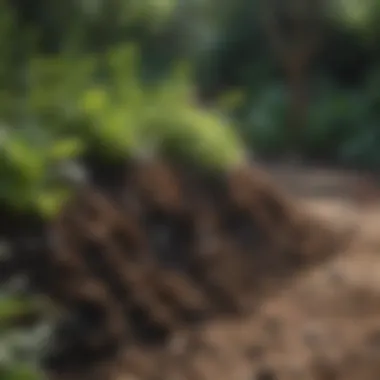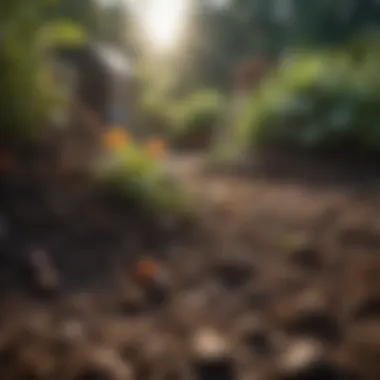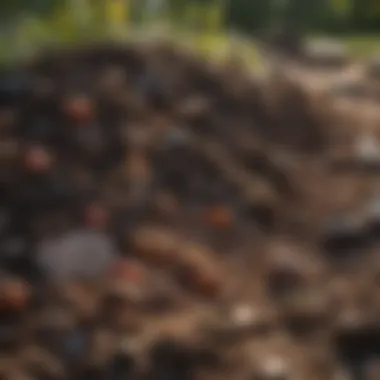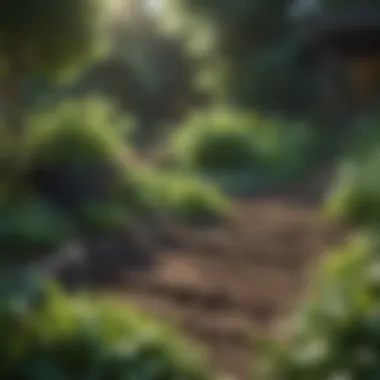Practical Uses of Compost for Gardens and Landscapes


Intro
Compost is often hailed as a gardener's best friend, yet its practical applications extend beyond mere soil amendment. It plays a crucial role in transforming gardens and landscapes into flourishing eco-friendly havens. The process of composting, which turns organic waste into nutrient-rich material, offers sustainable benefits that can elevate not just the health of plants but also the entire green ecosystem surrounding them.
Understanding how compost integrates into various garden and landscape settings is essential for anyone looking to embrace a more responsible and effective gardening approach. This article aims to explore the extensive uses of compost, illustrating how it can nurture plants, improve soil texture, and mitigate environmental impacts. We'll discuss different application techniques, potential benefits, and specific suggestions to get you started on your composting journey.
With rising interest in sustainable gardening practices, compost has emerged not just as a trend but as a necessity for conscientious gardeners and landscapers alike. From the smallest balcony herb garden to sprawling community parks, the advantages of compost are undeniable.
As we navigate through this guide, keep an open mind, and prepare to discover the untapped potential lying in your compost pile.
Understanding Compost
Gaining a solid understanding of compost is pivotal for anyone with a patch of earth, whether it be a small balcony or a sprawling estate. Compost serves as a cornerstone for nurturing vibrant gardens and landscapes. It’s not merely a mere mix of organic matter; it’s a beneficial transformation of waste into a powerful soil amendment. The journey toward a thriving garden is deeply entwined with comprehending what compost truly is, how it’s put together, and how it breaks down.
What is Compost?
At its core, compost is the result of nature’s recycling process. It can be defined as decomposed organic material that enriches soil. It is a blend of plant materials, kitchen scraps, and sometimes even animal waste, all combined to create a dark, nutrient-rich substance that notably enhances the quality of garden soil. By using compost, gardeners are not only improving their soil but also reducing waste, making compost a fitting example of sustainable gardening practices. It is important to distinguish compost from mere mulch or fertilizer - while these might serve their purposes, they do not provide the comprehensive benefits found in well-crafted compost.
The Composition of Compost
Understanding what goes into compost offers gardeners insight into its effectiveness. Compost is typically made up of three primary components:
- Greens: These are nitrogen-rich materials, such as grass clippings, fruits, and vegetable scraps. They provide crucial nutrients for the microbial process.
- Browns: In contrast, browns are carbon-rich items, including dried leaves, twigs, and paper. They help balance moisture and aeration in the pile.
- Water: Maintaining adequate moisture levels is essential for the decomposition process, ensuring microorganisms thrive and break down the materials effectively.
A proper ratio of greens and browns ensures a diverse array of nutrients. For instance, a common recommendation is a 2:1 ratio of browns to greens. This mix creates the perfect breeding ground for beneficial microbes that in turn break down the organic matter.
The Decomposition Process
The magic of compost occurs during the decomposition process, which can be broken down into three stages:
- Mesophilic Stage: This initial phase is when moderate-temperature microorganisms consume the easily digestible materials. Temperatures may rise quickly during this stage, often reaching between 100°F to 140°F (38°C to 60°C).
- Thermophilic Stage: As the decomposition progresses, thermophilic bacteria take over, further breaking down the tougher materials. This stage can push temperatures to as high as 160°F (71°C), efficiently destroying pathogens and weed seeds.
- Curing Stage: Finally, as the temperature declines and materials have broken down, the compost enters the curing phase. This stage allows the compost to stabilize, enhancing its structure and developing beneficial properties.
Composting is nature's way of recycling; it not only reduces waste but also promotes soil vitality.
Understanding these facets of compost equips gardeners with the knowledge needed to enhance garden quality, reinforcing the idea that effective composting lies at the heart of sustainable gardening practices.
By integrating composting into your routine, you embrace a holistic approach to gardening that fosters plant growth while minimizing your environmental impact.
Benefits of Using Compost
The utilization of compost in garden and landscape settings is not merely a trend but rather a return to a more sustainable and productive agriculture practice. Composting enriches soil and promotes healthy plant growth, effectively transforming organic waste into a vital resource. It stands out for its multifaceted benefits, addressing nutritional, structural, and ecological needs of various garden types. Understanding these advantages is paramount for gardeners seeking to enhance their landscapes while also nurturing the environment. Below are the key benefits that compost brings to the table.
Improving Soil Structure
One of the most significant advantages of compost is the enhancement of soil structure. Good soil structure is critical for plants; it allows roots to penetrate easily and helps prevent compaction. Compost introduces organic matter into the soil, which helps create aggregates. These aggregates are like little clumps that form spaces for air and water. You can liken it to building a sponge; the more well-structured and porous the soil, the better the water retention, drainage, and aeration.
When you incorporate compost into your soil, the ecosystem within changes dramatically. The soil becomes less dense, allowing essential nutrients and water to flow freely to plant roots. Over time, this improvement can lead to healthier, more vigorous plants. This aspect is particularly important in clay soils, where compaction can be a real issue. Compost lightens the texture, making it easier for roots to spread their wings.
Enhancing Nutrient Availability
Plants require a myriad of nutrients to grow, and compost is a powerhouse of these essentials. With compost, the soil is given a boost of nitrogen, phosphorus, potassium, and other micronutrients that are critical for plant health. Unlike synthetic fertilizers, compost releases nutrients slowly. This slow-release characteristic ensures that plants can access and absorb these nutrients when they need them, reducing the risk of leaching and nutrient run-off.


Moreover, compost helps prevent soil nutrient depletion, a common occurrence with conventional farming methods. By replenishing the soil's nutrient reserves, compost not only supports plant growth but also contributes to a cycle of sustainability that benefits future crops. Here’s an interesting side note: In many traditional farming cultures, composting was seen as a natural extension of the growing process, illustrating a historical understanding of its value.
Moisture Retention Capabilities
Water management can be a thorn in the side of any gardener. Compost is like a sponge, capable of holding moisture far better than plain soil. It allows the garden to go longer between waterings, which can be a lifesaver during dry spells. By enriching the soil with compost, plants gain access to a reservoir of moisture that they can tap into as needed.
Additionally, the increase in organic material helps create a balanced environment where soil can retain moisture without becoming soggy. This is particularly vital in sandy soils, which tend to drain quickly. The moisture retention offered by compost can therefore save both time and resources, ensuring healthier plants even during harsher conditions.
Supporting Soil Microorganisms
Compost is teeming with beneficial microorganisms and fungi that contribute to soil health. These tiny workers play a pivotal role in breaking down organic matter and turning it into forms that plants can utilize. It’s a symbiotic relationship: the microorganisms get food from the compost, while the plants receive essential nutrients and support for their growth.
Healthy soil populated with diverse microbial life helps combat pests and diseases. These microbes often outcompete harmful pathogens, providing an additional layer of protection for the plants. Without them, soil can become a barren wasteland where nutrient cycling is ineffective.
"Healthy soil is alive! It’s a community of organisms working together to support plant life."
In summary, the benefits of using compost in gardens and landscapes cannot be overstated. From enhancing the very fabric of the soil to fostering a robust ecosystem for plants, compost serves as a crucial ally in any gardening endeavor. By understanding these uses and advantages, gardeners can craft landscapes that are not only beautiful but also ecologically sound.
How to Apply Compost
Applying compost in gardens and landscapes is crucial for achieving vibrant and fruitful growth. It enriches the soil with nutrients and enhances its overall structure. Not only does compost help in building healthier plants, but it also promotes sustainable gardening practices that can benefit the environment. By understanding how to effectively apply compost, gardeners can achieve better results with their plants while ensuring their techniques align with eco-friendly methods.
Top Dressing for Gardens
Top dressing involves spreading a layer of compost over the surface of the soil in your garden beds. This method boosts soil health by slowly adding nutrients to the plants while improving moisture retention. It’s a simple process that can make a significant difference.
- Timing: Spring and fall are the best times to top dress your gardens. Apply after a rainfall or during moderate weather.
- Application: Spread a thin layer, about half an inch to an inch thick, over the soil surface.
- Benefits: This technique prevents erosion, reduces weed growth, and allows for organic matter to gradually integrate into the soil.
Incorporating into Flower Beds
Integrating compost into flower beds marries its benefits directly with the plant roots. This approach can significantly elevate the health of your blooms and foliage.
- How to Mix: Till the compost into the top 6-12 inches of soil around your flower beds. Prior to planting, or during the early spring, is often the best time for incorporation.
- Benefits: Helps flower plants establish stronger root systems, promotes vibrant blooms, and provides essential nutrients right where they are needed.
Mixing with Potting Soil
Creating your own potting mix is both fulfilling and economical. Mixing compost with potting soil is an excellent way to enhance container gardens.
- Recipe: A mix of 1 part compost, 2 parts peat moss or coconut coir, and 1 part perlite or vermiculite works well for most plants.
- Usage: This blend provides proper drainage while still retaining moisture and nutrients. Ideal for houseplants and patio potted plants.
- Enhancement: Potting soil enriched with compost not only nourishes plants but also helps in maintaining aeration, promoting healthier root development.
Using Compost Tea
Compost tea is a liquid method of applying the nutrients found in compost. This process extracts the valuable elements into water, providing plants with a quick nutrient boost.
- How to Brew: Steep a bag of finished compost in a bucket of water for 24-48 hours. Strain to remove solid particles before application.
- Application: This liquid gold can be sprayed directly onto leaves or poured around the base of your plants.
- Benefits: Plants absorb nutrients more rapidly in liquid form, promoting faster growth and recovery from stress.
"Applying compost, be it through top dressing or compost tea, can redefine a garden’s vitality, reinvigorating both the soil and the plants that depend on it."
Adopting these various compost application methods can yield astonishing results in your garden. By tailoring your approach based on your specific gardening needs, you can foster an environment conducive to growth, health, and sustainability.
Compost in Different Garden Types
Understanding how compost can be used across various garden types is essential for any gardener looking to enhance their landscapes efficiently. Each garden type has its distinct needs concerning soil quality, nutrients, and overall ecological balance. Tailoring compost applications to specific garden types not only optimizes plant health but also fosters sustainable gardening practices conducive to long-term growth and biodiversity.


Vegetable Gardens
Vegetable gardens thrive on nutrient-rich soil, making compost one of the best allies for vegetable growers. When integrating compost into vegetable patches, the organic matter enhances soil fertility and structure, resulting in higher yields.
It's recommended to mix compost into the soil before planting to ensure even distribution of nutrients. Moreover, vegetables like tomatoes, peppers, and beans extract various nutrients from the soil. With compost, they get crucial elements like nitrogen, phosphorus, and potassium in a natural form, which helps resist pests and diseases.
Considerations:
- Apply compost in the fall or early spring, tilting it into the top 6 inches of soil.
- Avoid using compost that comes from garden waste treated with pesticides, as it could introduce harmful chemicals into your food supply.
Herb Gardens
Herbs are known for their distinct flavors and aromatic qualities, and the quality of soil significantly influences their growth. Compost allows herb gardens to flourish by providing essential nutrients and retaining moisture, which is key for herbs like basil, rosemary, and thyme.
Instead of relying solely on chemical fertilizers, using compost is a more natural way to feed your plants. Mixing compost into herb gardens promotes better drainage and aeration, which is crucial given that overwatering can often lead to root rot. Think of compost as the secret ingredient that turns your average herb garden into a lush pantry.
Key Points to Remember:
- Top-dress your herbs with a thin layer of compost throughout the growing season to sustain nutrient levels.
- Ensure the compost is finely sifted to prevent large clumps that can suffocate young plants.
Flower Gardens
Flowers are not only visually stunning but also contribute to the landscape's overall ecological health. Compost plays a vital role in supporting flowering plants by improving soil texture and microbial activity. For flower gardens, enriching the soil with compost can lead to more vibrant blooms and prolonged flowering periods.
When preparing flower beds, incorporating compost helps with moisture retention, especially in sandy soils where water tends to drain too quickly. Flowers like daisies and sunflowers particularly benefit from nutrient boosts during their growing phase, promoting sturdier stems and fuller blooms.
Tips for Flower Garden Composting:
- Mix compost when preparing the flower beds in spring or fall before planting.
- Consider using a compost tea diluted with water for a quick nutrient fix during peak blooming seasons, providing a much-needed boost.
Container Gardens
Container gardens present unique challenges, primarily in nutrient retention and soil aeration. Compost becomes incredibly important here as it helps create a robust soil environment even in confined spaces. Using compost in pots or raised beds enhances the growth of decorative plants and vegetables alike, ensuring they don’t become stunted.
A combination of compost with potting soil can improve drainage, while also keeping moisture levels good. This balance is crucial for plants such as herbs or small vegetable varieties grown in containers, allowing them to thrive despite limited root space.
Practical Tips for Containers:
- Use compost mixed with potting soil in a ratio of 1:3 for optimal results.
- Rotate the compost every six months to maintain oxygen levels which are essential for healthy roots.
Ultimately, the key to a successful application of compost across different garden types lies in understanding the unique requirements of each setting. With a little planning and consideration, compost can truly transform any garden into a bountiful oasis.
Sustainable Practices with Compost
The rise of sustainable practices in gardening has taken center stage in recent years. One fundamental aspect of these practices is composting. Incorporating compost into your gardening routine not only enhances soil health, but also fosters an environment that is conducive to the well-being of plants, soil organisms, and the surrounding ecosystem. Through this, gardeners can reduce their ecological footprint while nourishing their green spaces.
Reducing Waste with Composting
Composting acts as a natural remedy for the growing problem of organic waste. In many households, a significant portion of what ends up in the landfills consists of vegetable scraps, coffee grounds, and yard waste. Instead of allowing these materials to decompose in a landfill, transforming them into compost can lessen the waste burden.
When you compost kitchen and garden waste, you’re engaging in a process that repurposes these items into a rich, beneficial soil amendment. This not only reduces the volume of waste sent to the landfill but also curbs the release of greenhouse gases that occurs when organic waste decomposes anaerobically in landfills.
A few easy steps for effective composting include:


- Collect organic waste: Keep a container in your kitchen for vegetable peels, eggshells, and leftover food.
- Layer your compost pile: Alternate between green materials, like fruit scraps, and brown materials, like dried leaves or cardboard.
- Maintain moisture: Make sure the compost remains damp but not soggy. Too much water can create a mess, while too little can slow down the decomposition process.
By adopting composting, you’re not just creating a nutrient-rich addition to your soil but also playing an active role in waste reduction.
Promoting Biodiversity
Biodiversity in the garden extends beyond the range of plants you cultivate. It encompasses the variety of life forms that interact within your garden ecosystem. Composting plays a pivotal role in promoting this biodiversity. When you apply compost, you’re feeding more than just your plants; you’re also providing a habitat and sustenance for a whole host of organisms, from earthworms to beneficial microbes.
These microorganisms break down organic matter, which helps to create a healthy ecosystem within the soil. The presence of diverse soil organisms in compost enhances nutrient cycling, improves soil structure, and increases the overall resilience of the garden against pests and diseases.
Additionally, a diverse garden attracts a wider array of beneficial species, such as bees and butterflies, which are essential for pollination. When we make room for composting in our gardening practices, we are also creating a sanctuary for these vital helpers.
Creating a Closed-Loop System
The concept of a closed-loop system in gardening is akin to a circular economy, where waste is minimized and resources are reused. With composting, gardeners have the opportunity to close the loop on their organic waste. You generate kitchen scraps, utilize them in your compost pile, and return those nutrients back to the soil to nourish future plants. This cyclical approach is the essence of sustainability.
Creating a closed-loop system helps maintain the balance of nutrients in your garden soil. It reduces dependency on synthetic fertilizers, which can often lead to depletion of soil health over time. As compost enriches the soil, it promotes healthy plant growth without the need for harmful chemicals. This also reduces runoff, which can contaminate water sources with excess nutrients.
In practice, achieving a closed-loop system means:
- Utilizing all organic kitchen waste: Be purposeful about what goes into your compost so as not to waste valuable nutrients.
- Recycling garden clippings and leaves: These materials provide essential carbon for the compost, returning nutrients to the soil.
- Developing a compost routine: Regularly adding and turning compost ensures efficient breakdown and nutrient cycling.
Overall, when you create a closed-loop system with your garden composting efforts, you’re fostering an environment that is self-sustaining, resilient, and capable of thriving over the long haul.
Challenges and Solutions
Addressing the challenges of composting is vital for gardeners wanting to reap all the benefits of this eco-friendly practice. While composting can greatly enhance soil health and support plant growth, various issues may arise that hinder the process. Understanding these challenges not only helps in overcoming them but also contributes to more effective compost application in gardens and landscapes.
Common Composting Issues
Several recurring issues can affect the composting process. Here are some typical problems that one might encounter:
- Unpleasant Odors: A foul smell can indicate an imbalance in nitrogen and carbon materials, often due to too much green matter such as kitchen scraps.
- Pests and Rodents: Attracting unwanted animals can be a significant concern, especially if food scraps are left exposed or improperly mixed.
- Slow Decomposition: If composting is going at a snail's pace, it may be due to inadequate aeration or insufficient moisture levels.
- Excess Moisture: Too much wetness can create swamp-like conditions, leading to anaerobic decomposition, which halts the composting process effectively.
- Compact Material: Overly compacted ingredients can greatly limit airflow, stymying the breakdown of organic matter.
These challenges can pose quite a headache, but keeping an eye on progress and understanding the root causes can pave the way for solutions.
How to Troubleshoot Problems
To tackle these composting issues head-on, consider the following approaches:
- For Odors: Adjust the carbon-to-nitrogen ratio by adding dry leaves or straw. Mixing the compost while aerating can help to revitalize stale conditions as well.
- For Pests: Minimize exposure by burying kitchen scraps several inches deep within the compost pile and using fine mesh covers to keep rodents at bay.
- For Slow Decomposition: Increase aeration by turning the compost more often. Monitor moisture levels and maintain an ideal balance of wet and dry materials.
- For Excess Moisture: If your compost is too wet, supplement it with dry materials like cardboard or wood chips. It helps in soaking up excess water and fosters air circulation.
- For Compacted Material: Break up clumps and mix the contents thoroughly to ensure proper airflow. Adding bulky material helps as well.
These practical solutions not only empower gardeners to effectively manage their compost piles but also enrich the overall gardening experience, creating a fruitful relationship between gardeners and nature.
To maximize the benefits of compost, it’s essential to stay mindful of potential challenges and actively seek ways to mitigate them.
End
Embracing the use of compost is fundamental for gardeners and landscapers seeking to enhance their outdoor spaces sustainably. Compost is not merely a soil amendment; it represents a holistic approach to gardening practices that benefits both plants and the environment alike. The myriad advantages of compost—from improved soil structure to enhanced nutrient availability—make it an invaluable tool in the pursuit of healthy gardens.
Looking ahead, the future of composting practices shows promising trends. Developing a culture of composting is critical as awareness rises regarding the necessity of reducing food waste. Beyond just recycling scraps, it's about cultivating a relationship with the soil, enriching it with value that supports biodiversity. Gardeners are becoming increasingly cognizant of how their practices influence local ecosystems. By fostering microbial life and maintaining soil health, compost ensures a robust growth environment for a diverse array of plants.
The Future of Composting Practices
The future underscores a shift towards innovative and efficient composting methods. With composting technology progressing, we can anticipate advancements that simplify the process for homeowners. One example is the rise of compost tumblers that enable faster processing of organic waste, thus making it easier for urban gardeners to participate. As gardeners, we're recognizing the importance of integrating these practices into our daily routines.
Furthermore, efforts are underway to create educational programs targeted at communities, aiming to install enthusiasm and knowledge about composting's benefits.
"Composting is not just a practice; it’s a lifestyle that encourages mindful consumption and stewardship of the environment."







